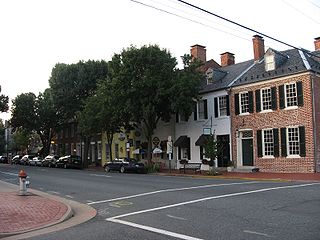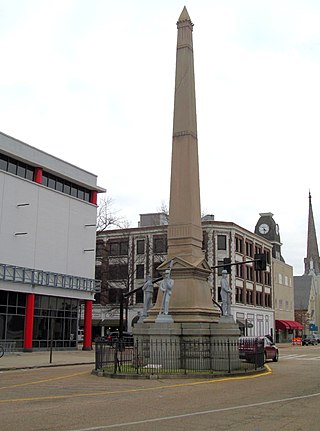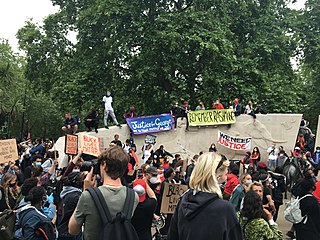
Spotsylvania County is a county in the U.S. state of Virginia. As of the July 2021 estimate, the population was 145,300. Its county seat is Spotsylvania Courthouse.

Fredericksburg is an independent city in Virginia, United States. As of the 2020 census, the population was 27,982. It is 48 miles (77 km) south of Washington, D.C., and 53 miles (85 km) north of Richmond. The Bureau of Economic Analysis of the United States Department of Commerce combines the city of Fredericksburg with neighboring Spotsylvania County for statistical purposes.

Monument Avenue is a tree-lined grassy mall dividing the eastbound and westbound traffic in Richmond, Virginia, originally named for its emblematic complex of structures honoring those who fought for the Confederacy during the American Civil War. Between 1900 and 1925, Monument Avenue greatly expanded with architecturally significant houses, churches, and apartment buildings. Four of the bronze statues representing J. E. B. Stuart, Stonewall Jackson, Jefferson Davis and Matthew Fontaine Maury were removed from their memorial pedestals amidst civil unrest in July 2020. The Robert E. Lee monument was handled differently as it was owned by the Commonwealth, in contrast with the other monuments which were owned by the city. Dedicated in 1890, it was removed on September 8, 2021. All these monuments, including their pedestals, have now been removed completely from the Avenue. The last remaining statue on Monument Avenue is the Arthur Ashe Monument, memorializing the African-American tennis champion, dedicated in 1996.
The United States National Slavery Museum was an unfunded proposal for a museum to commemorate American slavery.

The Statue of Lenin is a 16 ft (5 m) bronze statue of Russian communist revolutionary Vladimir Lenin in the Fremont neighborhood of Seattle, Washington, United States. It was created by Bulgarian-born Slovak sculptor Emil Venkov and initially put on display in the Czechoslovak Socialist Republic in 1988, the year before the Velvet Revolution. After the revolutions of 1989 and dissolution of the Soviet Union, a wave of de-Leninization in Eastern Europe brought about the fall of many monuments in the former Soviet sphere. In 1993, the statue was bought by an American who had found it lying in a scrapyard. He brought it home with him to Washington State but died before he could carry out his plans to formally display it.

The Confederate Monument in Portsmouth, Virginia, was built between 1876 and 1881. It was listed on the National Register of Historic Places (NRHP) in 1997.

Appomattox is a bronze statue commemorating soldiers from Alexandria, Virginia, who had died while fighting for the Confederacy during the American Civil War. The memorial was located in the center of the intersection of South Washington Street and Prince Street in the Old Town neighborhood of Alexandria.

The Robert E. Lee Monument in Richmond, Virginia, was the first installation on Monument Avenue in 1890, and would ultimately be the last Confederate monument removed from the site. Before its removal on September 8, 2021, the monument honored Confederate Civil War General Robert E. Lee, depicted on a horse atop a large marble base that stood over 60 feet (18 m) tall. Constructed in France and shipped to Virginia, it remained the largest installation on Monument Avenue for over a century; it was first listed on the National Register of Historic Places in 2007 and the Virginia Landmarks Register in 2006.

There are more than 160 monuments and memorials to the Confederate States of America and associated figures that have been removed from public spaces in the United States, all but five of which have been since 2015. Some have been removed by state and local governments; others have been torn down by protestors.
The Charlottesville historic monument controversy is the public discussion on how Charlottesville should respond to protesters who complain that various local monuments are racist. The controversy began before 2016 when protest groups in the community asked the city council for the local removal of Confederate monuments and memorials. Other monuments became part of the controversy, including those of Thomas Jefferson because of his ownership of slaves and those of Lewis and Clark for their advocacy of white colonists over Native Americans.

Richmond, Virginia, experienced a series of protests in the wake of the murder of George Floyd. Richmond was the first city in the Southeastern United States to see rioting following Floyd's murder. Richmond, formerly the capital of the short-lived Confederate States of America, saw much arson and vandalism to monuments connected with that polity, particularly along Monument Avenue.

This is a list of George Floyd protests in Virginia. Following the murder of George Floyd by a police officer, protests spread from Minneapolis to other parts of the United States, including Virginia. Protests broke out in Richmond on the night of May 28 and spread to over 50 other cities over the following days.

Protests were held across the United Kingdom following the murder of George Floyd, a 46-year-old African-American man, by a police officer in the United States on 25 May 2020. Immediately following his murder, protests and riots occurred in dozens of cities across the United States. Protests were staged internationally for the first time on 28 May, with a solidarity demonstration outside the United States Embassy in London. They took place during the UK COVID-19 pandemic.

The statue of Edward Colston is a bronze statue of Bristol-born merchant and trans-Atlantic slave trader Edward Colston (1636–1721). It was created in 1895 by the Irish sculptor John Cassidy and was formerly situated on a plinth of Portland stone in a public space known as "The Centre" in Bristol, until it was toppled by anti-racism protestors in 2020.

The murder of George Floyd on May 25, 2020, triggered a wave of protests throughout Tennessee in late May and early June 2020. These protests continued throughout the year.

The statue of John Cass is a lead figure by Louis-François Roubiliac of John Cass (1661–1718), the English merchant and Member of Parliament. The original statue of 1751 now stands in the Guildhall in London. There is also a fibreglass replica at the School of Art, Architecture and Design at London Metropolitan University in Jewry Street, installed in 1998.

A number of statues and memorials were the subject of protests and petitions during the George Floyd protests in the United Kingdom in 2020.

The Old Market is a historic open-air structure in the middle of Louisville, Georgia. It was built around 1795 during the period when this town was the capital of Georgia. It was entered into the National Register of Historic Places on February 17, 1978. The structure was built as a public market but was also sometimes used as a slave market. Amid the George Floyd protests in 2020, the city council of Louisville voted to have the structure removed from the town.


















